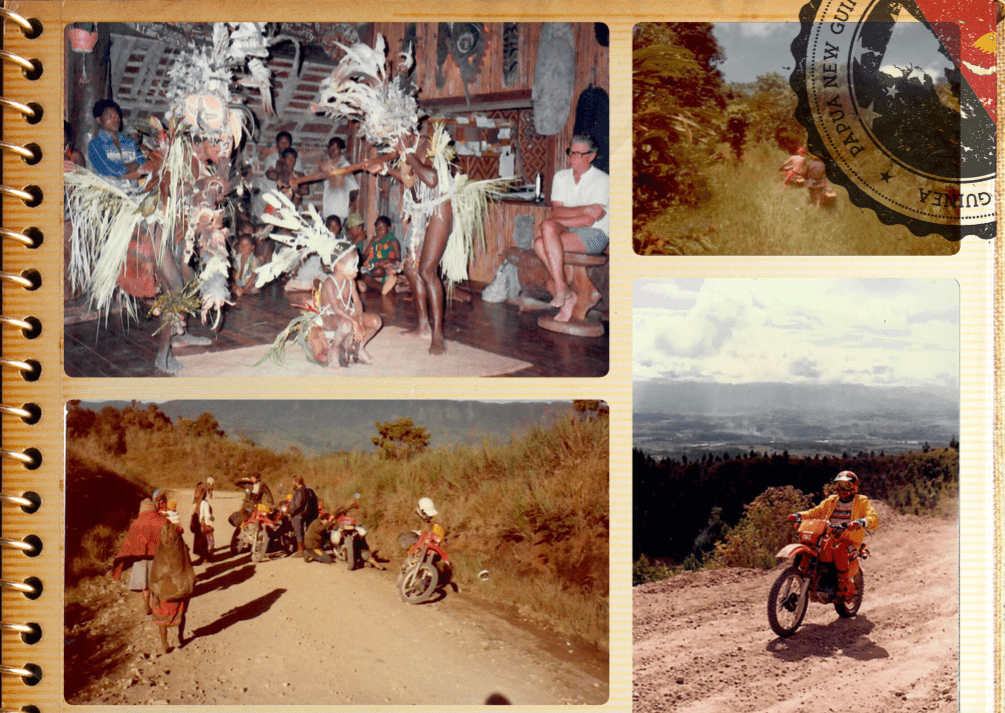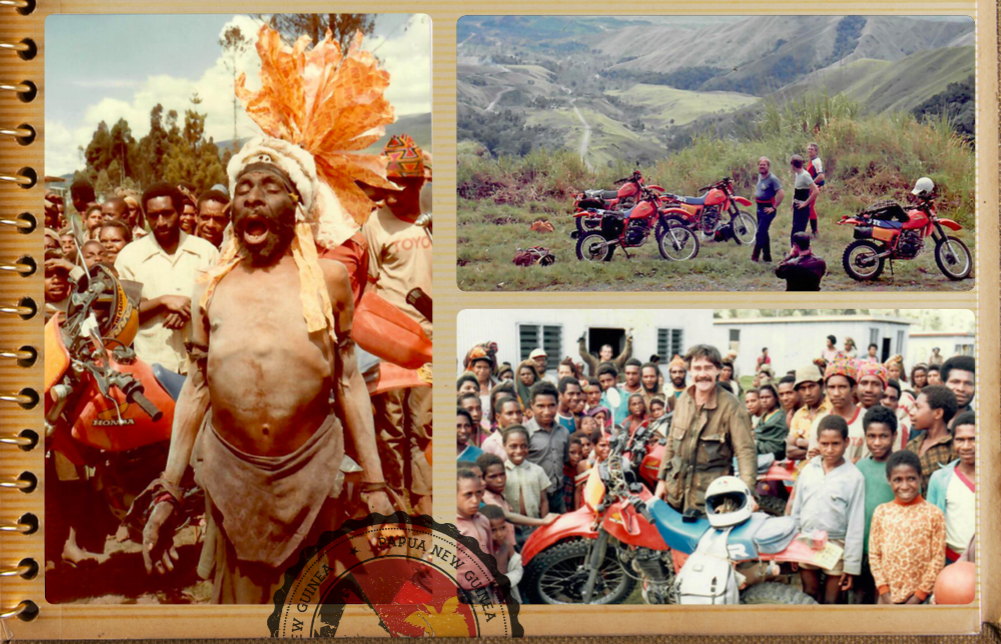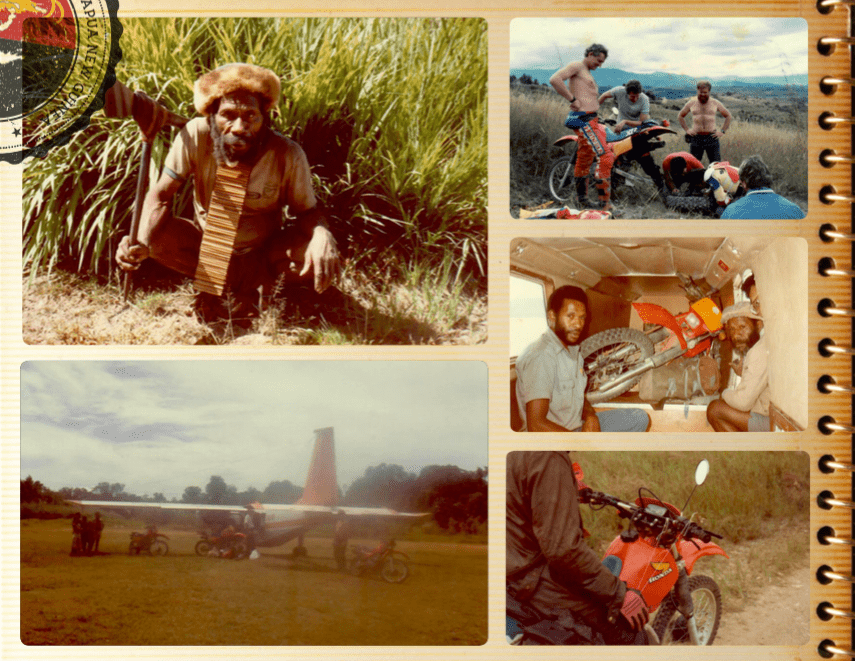Back in the mid-80s, before ‘adventure’ was a market genre, Peter Whitaker and his mates packed up a posse of Honda XRs and hit the trails of Papua New Guinea.
During the 1970s, dourly clad missionaries roamed the coastal tracks of New Guinea spreading the word of the saviour. Mounted on dun-coloured mopeds they were known as the bike brigade. Then, in 1984, we arrived. As we unloaded a brace of bright blue and red Honda XRs at the tiny Lae airport in 1984 and donned our riding clobber, we were surrounded by locals and a customs officer who said: “You got plenty bilas. You Bigpella Bike Brigade.” We had no idea what he meant but basked in our newfound celebrity status.
We’d chosen New Guinea for a riding adventure simply because a mate who regularly dived the coral reefs there assured us he could organise the logistics – such as a supply of SP Lager every evening. The provincial authorities weren’t so keen on our plan and gave us dire warnings about ‘raskols’ in the highlands. One bloke even offered us a .45 revolver as protection. But in the end nothing presented more danger than the surfeit of SP Lager and all cautions went unheeded as we climbed the coastal range, tipped over the ridgeline and found the track hemmed in by rainforest.
On hearing our approach, machete-wielding natives would burst frighteningly from the dense foliage only to double up in merriment at the passing parade. However the notion of collecting one of these excitable spectators or, worse still, one of their wildly waving scythes, kept us on edge.

The settlement of Goroka was small enough for our group to become the evening’s entertainment and during a raucous night at the Bird of Paradise Hotel, a local enthusiast named Roger offered to take us on a ride ‘off the beaten track’. Despite our apprehension that Roger had assumed the capability of our machinery might be matched by the ability of the riders, refusal was impossible and our every fear was realised the following morning when Roger arrived riding a Suzuki motocrosser and wearing body armour.
At a little under 4000 metres Goroka is all but twice the elevation of Mount Kosciosko yet it seemed we climbed for hours on a loose shale logging track and then even higher up a muddy, narrow trail before the ascent reached an impassable scramble. “Now it’s back the same way” advised Roger “but you’ll have to put on a bit of a show”. Sensing our confusion he explained. “Everyone within coo-ee knows we have to go back down the same track and they’ll be waiting. There’s not much entertainment in the highlands.”
And so it was. At every ledge and gully, on the inside and outside of every sharp twist and turn, it seemed that entire tribes had gathered, cheering clapping laughing and, all too often, jumping in front of the descending machines in a show of bravado; reaching out to touch each rider as they wobbled past. If only they’d realised how inexperienced we were or how ridiculously carefree we’d become they may have been more circumspect. Finally, in the foothills, a sidetrack then led us to a group of low thick slab walled huts with thatched roofs and earthen floors. Each with a single tiny entrance. To keep warm during cold nights the inhabitants – often entire families – of these tiny, igloo like, dwellings, cover their entire bodies in pig’s lard closing the pores of their skin and trapping natural body heat. No prizes for guessing what else it traps; which is why a visit to the living quarters of a highland family should last no longer than ten seconds. After the obligatory photo session we quickly moved on and soon arrived at a substantial village built around a large communal green. Within minutes we were besieged by scores of villagers pressing us into an almost defensive circle. There was no malice, simply curiosity; however we were concerned one of the small children would be pushed against a hot engine or exhaust.
Then the witchdoctor arrived with an official welcome. At least we assumed he was the witchdoctor as he wore a very impressive headpiece; it was only later we realised it was made entirely of colourful waxed bread wrappers. His frenzied jabbering had some success in parting the now impressive crowd and we were totally bemused as he greeted each one of us as a long lost friend, stroking our crash helmets and bikes; by this time we’d learnt that any vibrant colour – or ‘bilas’ as it’s locally known – is symbolic of power and authority. It was certainly obvious that this bloke found the bright red, blue, yellow and chrome of the Hondas and in particular Roger’s body armour most impressive; with dusty Belstaffs and old football socks on the bottom rung of power dressing. Not surprisingly it was Bob, in his chrome yellow rainjacket over a tricolour Honda riding shirt that took our new mate’s fancy. When Bob responded with a friendly ‘g’day’ the witchdoctor shoved a yam into his own mouth, fell to the ground and began gyrating and moaning to the delight of the immediate onlookers.

More and more people joined the outer circle to see what the commotion was about and the crowd now numbering over 300 boisterously happy people, made the situation a little intimidating. And the crush became suffocating leaving no room to swing a leg over a bike. But someone succeeded and as soon as the first machine lit up the immediate bystanders jumped back; the ripple effect causing havoc. It was a minor miracle no one got clobbered in our hasty departure back to Goroka. After the morning’s hectic activities the ride along the main track to Minj was anticlimactic yet threw up many challenges as the track wound through countless small hamlets crowded with people and livestock.
Minj is the base for scuba diving in the world’s deepest volcanic lake however our interests lay elsewhere, so early the following day we headed westwards, continually climbing on a surface that changed regularly from loamy soil, to sticky mud, shale and large gibber sections that gave the Loc-tite a real test. There were fewer villages and even fewer travellers in this remote region and on the torturous route between Mendi and Wabag we met a lone nomad wearing a finely crafted breastplate of polished sticks. He was most surprised to encounter a bunch of blokes riding around his bailiwick in fancy dress. We were later informed that each of these sticks represented some charitable service performed by the old bloke. And that they were transferable currency, so that the `stick man´ could obtain some favour by paying with a stick. The recipient would then be in credit to the person who originally crafted the stick; an ancient form of Bartercard.
We could have done with a few favours later that day when Patrick highsided on a particularly gnarly section of downhill gibber, taking a large chunk of flesh from his right forearm and dislocating his shoulder. Keeping tropical infection from the wound was paramount; our other concern was how Patrick could continue with his right arm virtually immovable. By wiring a short stick to the throttle and a length of string he could twist the throttle about 20mm – more than was necessary given the situation. Forward progress was horrendously slow but eventually we reached our evening digs; Kaiap Lodge.

Next day we had an imperative rendezvous at Mount Hagen but Patrick required proper medical attention and we were fortunate enough to rouse a young M.O. at a nearby missionary clinic. Whilst Patrick was being patched and stitched I was surprised at the scale of medical fees on the notice board. Fees which focussed on knife, spear and axe wounds; surely some intern’s joke. But no, as the M.O. explained, the fees were an economic attempt to reduce violence by putting the ‘payback’ system into place. Simply put, if you know it’s going to cost two piglets in recompense you might think twice before you whack your opponent in the head with an axe!
Patrick repaired we headed for Mount Hagen airport where, at the appointed hour two Northern Islander aircraft were wheeled from the hangars. It took some doing but eventually three bikes were loaded aboard each craft with three of us jammed into each tiny cabin, the two planes bumped their way over the short, grassy runway. I needed no reminding that hangovers and claustrophobia are not natural mixers as thermals and windgusts kept everyone unusually quiet. That and the ever present thought of the large number of light aircraft that go missing in New Guinea’s treacherous highlands.
From the tiny airstrip in the jungle it was only a short ride to our lodge on the banks of the Karawari River. Our intention had been to spend the next day riding in the mountains around the lodge. However as the only navigable tracks consisted of the short trip to the airfield and a kilometre of rutted pathway to a nearby village, the riding was all over by cocktail time. And very colourful cocktails they were. Lots of ‘bilas’.
We were more than apprehensive when we sighted the dugout canoes that were to be our transport down the Karawari River to the coast. With gunwales mere inches above the waterline these canoes appeared decidedly unstable when loaded with our bikes; however the natives knew what they were about even if we didn’t. Late that day we were disembarking at Timbunke for the short ride to Wewak and were reminded yet again of the isolation of this part of the world by the total lack of vehicles – any of which must come in by sea freight. So there was no shortage of inhabitants totally amazed by the sight of us belting along over the sandy coastal tracks.

Wewak was a sizable town. With more than a single street; a fact that was to cause us some trouble later on. But not before a big night out at the `local´ where every night is party night particularly when six thirsty guests are buying drinks for the band – whose principal instrument was a percussion piece consisting of bamboo tubes of various lengths and diameters. When thumped with a pair of rubber thongs the effect is quite musical; though “Tubular Bongs” was never a big hit when exported.
Sometime the next morning someone was reported as having ridden the wrong way up the ‘one way’ shopping loop, the problem exacerbated by the fact that the perpetrator could not be identified because they were wearing a helmet. Patrick, his head aching as much as his arm, patiently explained the situation to the accuser, a short dark individual in a very colourful – and therefore powerful – floral shirt. Somewhat forcefully, Patrick noted there were no traffic signs; and that there were many other deficiencies in town planning. Unfortunately the short dark person in the powerfully coloured shirt just happened to be the Mayor who stated his case, quite simply, `Everyone knows this is a one way street so why bother to replace the sign.

We were corralled and, with one Land Rover full of Police leading the way and a second as rearguard, were escorted to headquarters. All was forgiven once we’d apologised to the Mayor, now in an even more powerfully coloured shirt and ceremonial sash. But we were no longer the ‘Bigpella Bike Brigade’. Now disgraced to the ‘Badpella Bike Brigade’ we were, ever so politely, shown the only road out of town.
Only an hour later we dismounted at a small jetty on the banks of the Sepik River to rendezvous with the ‘Melanesian Explorer’. Whilst it had been many years since the bow of this venerable island trader tasted any champagne it was a most relaxing cruise and, moored at sunset in Karin Bay, watching the colourful explosions of the live volcano that dominates Mannum Island we reflected on an amazing adventure. News of which had reached the local media and, on disembarking at Madang for our return ride to Lae airport, we all enjoyed our fifteen minutes of fame being interviewed for TV before fumigation of bodies and bikes for the flight home.
A webcheck indicates tours of New Guinea are inadvisable but with a little planning you could make this your next adventure.

WORDS PETER WHITAKER
Travel advice
Current guides to Papua New Guinea reveal that many things are much the same today. This year’s Lonely Planet advises that driving around Papua New Guinea is not really a viable way of travelling because there are few roads that connect two or more places. Road conditions are variable and come with a range of hazards. Then there’s the wet season: it rains and you get bogged. On top of that there’s the ‘raskol’ (bandit), and it’s worth reading up on what to do if that happens to you.
Should you hit an animal going through one of the towns, stop at your own risk. Tribal concepts of payback apply. You may have insurance but the local citizenry may prefer to take more immediate and satisfying action.
Nothing much has changed in 30 years and had we known the above before we boarded our Air New Guinea flight well… we wouldn’t have done anything differently!